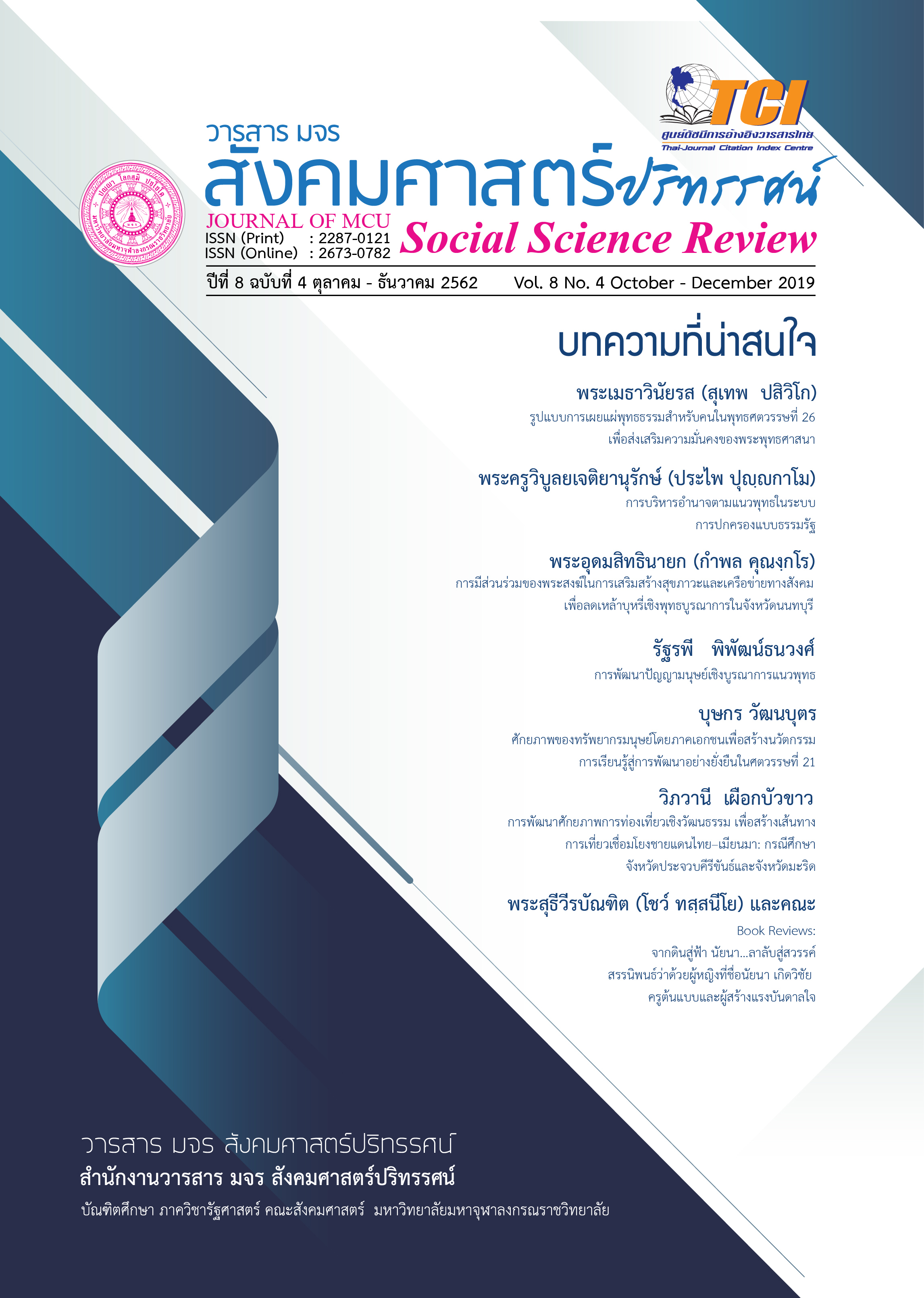การจัดการวัดให้เป็นแหล่งท่องเที่ยวเชิงวัฒนธรรม จังหวัดสมุทรสงคราม
คำสำคัญ:
การจัดการวัด, การท่องเที่ยวเชิงวัฒนธรรมบทคัดย่อ
บทความเรื่องนี้ มีวัตถุประสงค์เพื่อ 1. การจัดการวัดให้เป็นแหล่งท่องเที่ยวเชิงวัฒนธรรม จังหวัดสมุทรสงคราม 2. นำเสนอรูปแบบการพัฒนาการจัดการวัดให้เป็นแหล่งท่องเที่ยวเชิงวัฒนธรรม จังหวัดสมุทรสงคราม
ระเบียบวิธีวิจัยเป็นเชิงคุณภาพ ที่ใช้การสัมภาษณ์เชิงลึก จากผู้ให้ข้อมูลสำคัญ 30 รูปหรือคน เพื่อศึกษาแนวทางการจัดการวัดให้เป็นแหล่งท่องเที่ยวเชิงวัฒนธรรม จังหวัดสมุทรสงคราม แล้วนำมาวิเคราะห์เพื่อหารูปแบบเบื้องต้นก่อนนำเสนอต่อการสนทนากลุ่มเฉพาะ เพื่อพัฒนารูปแบบให้มีความสมบูรณ์ยิ่งขึ้น และนำเสนอต่อเวทีประชาพิจารณ์ เพื่อให้ได้รูปแบบที่เป็นมาตรฐานก่อนที่จะนำเสนองานวิจัยต่อสาธารณะ
ผลการวิจัย พบว่า
- การจัดการวัดให้เป็นแหล่งท่องเที่ยวเชิงวัฒนธรรม จังหวัดสมุทรสงคราม พบว่า ด้านศาสนสถาน ได้แก่ สิ่งปลูกสร้างที่มีความสำคัญทางพระพุทธศาสนา อันแสดงถึงศิลปวัฒนธรรมที่มีมาตั้งแต่อดีต ซึ่งแต่ละท้องถิ่นก็จะมีศิลปะที่แตกต่างกันออกไป การดูแลให้คงอยู่ในสภาพเดิมจึงเป็นเรื่องยาก เนื่องจากมีอายุและความเก่าแก่ด้วยประการหนึ่ง และการจะหาช่างฝีมือที่มีความสามารถจริงๆ ก็ยาก จึงต้องมีผู้ที่มีความรู้และความเข้าใจในการดูแลบูรณะซ่อมแซมให้คงสภาพเดิมไว้ให้ได้มากที่สุด ในส่วนของสิ่งปลูกสร้างอื่น ที่สร้างใหม่ ก็ควรสร้างให้มีรูปแบบที่เป็นศิลปะที่เป็นไปในทิศทางเดียวกัน ด้านบุคคล เป็นสิ่งสำคัญ เพราะบุคคลหรือมนุษย์เป็นตัวแปรสำคัญในทุกๆ เรื่อง การมีบุคลากรที่ดี มีทักษะ และความสามารถ ก็จะช่วยส่งเสริมและสนับสนุนให้การท่องเที่ยวก้าวไปสู่ตลาดโลกได้อย่างรวดเร็ว เรื่องของบุคคลจึงกลายเป็นเรื่องที่มีความสำคัญค่อนข้างมากที่สุด ด้านกิจกรรมภายในวัด ทุกๆ วัด ก็จะมีกิจกรรมทางพระพุทธศาสนา เนื่องในวันสำคัญทางพระพุทธศาสนาอยู่แล้ว โดยเฉพาะวัดใดที่มีพระพุทธรูปศักดิ์สิทธิ์ มีความสำคัญและเก่าแก่ ก็จะมีผู้คนให้ความศรัทธานับถือเป็นจำนวนมาก เช่น หลวงพ่อบ้านแหลม ที่ประชาชน นักท่องเที่ยว ต่างก็หลั่งไหลกันเข้ามาเพื่อสักการะสักครั้งหนึ่งในชีวิต แต่ทั้งนี้ กิจกรรมอื่นๆ ที่จะช่วยส่งเสริมการท่องเที่ยวให้มีความเจริญเติบโตเพิ่มมากขึ้น ก็มีอีกมากมาย เช่น งานประจำปีของวัด การจัดปฏิบัติธรรมประจำปี หรือสร้างกิจกรรมขึ้นในช่วงเทศกาลหรือวันหยุด ด้านสิ่งแวดล้อม เป็นอีกด้านที่มีตัวแปรในการควบคุมค่อนข้างยาก สิ่งแวดล้อมภายใน ได้แก่ อาณาเขตบริเวณภายในวัดและรอบๆ วัด ที่มีการดูแลจัดการรักษาความสะอาด และมีความเป็นระเบียบเรียบร้อย เหมาะแก่การรับรองนักท่องเที่ยวที่มาเยือน ซึ่งแต่ละวัดสามารถบริหารจัดการได้ด้วยตนเอง แต่สิ่งแวดล้อมภายนอก เช่น ร้านขายของที่ระลึก ร้านเครื่องดื่ม ร้านอาหาร ต่างๆ เหล่านี้ ซึ่งวัดไม่สามารถควบคุมได้ จึงต้องมีความร่วมมือกันทุกฝ่ายที่จะไม่สร้างบรรยากาศสิ่งแวดล้อมให้หม่นหมอง ด้วยการเอารัดเอาเปรียบนักท่องเที่ยว หรือการไม่ช่วยกันดูแลรักษาความสะอาด ไม่ใส่ใจซึ่งกันและกัน ซึ่งอาจเป็นปัญหาตามมาในภายหลังมากมาย
- รูปแบบการจัดการวัดให้เป็นแหล่งท่องเที่ยวเชิงวัฒนธรรม จังหวัดสมุทรสงคราม ด้านศานสถาน มีแผนงาน คือการอนุรักษ์โบราณสถานและโบราณวัตถุให้มีความมั่นคงแข็งแรง และคงไว้ซึ่งเอกลักษณ์ความเป็นไทยอย่างแท้จริง ด้วยการบูรณปฏิสังขรณ์โบราณสถานเก่าให้มีความมั่นคง แข็งแรง และก่อสร้างศาสนสถานใหม่ที่คงเอกลักษณะความเป็นไทย และวิถีชีวิตชุมชนอย่างชัดเจน โดยปรึกษาหารือกับผู้มีความเชี่ยวชาญกับกรมศิลปากร ด้านบุคคล มีแผนงาน คือ การพัฒนาทักษะทางด้านภาษาและวัฒนธรรมท้องถิ่นของบุคลากรอย่างมีประสิทธิภาพ โดยการพัฒนาทักษะความรู้เกี่ยวกับประวัติความเป็นมาของท้องถิ่นและทักษะทางด้านภาษาแก่บุคลากรอย่างมีประสิทธิภาพ และพัฒนาวัดเป็นศูนย์กลางการเรียนรู้ทางด้านศิลปวัฒนธรรมและประวัติศาสตร์ท้องถิ่น ด้านกิจกรรมภายในวัด มีแผนงาน คือ กิจกรรมการท่องเที่ยวลักษณะปฏิบัติธรรมบูรณาการกับการอนุรักษ์โบราณสถานและศึกษาประวัติศาสตร์ โดยการส่งเสริมและสนับสนุนกิจกรรมการปฏิบัติธรรมเชิงรุกให้แก่ประชาชน ส่งเสริมและสนับสนุนกิจกรรมการอนุรักษ์และปลูกจิตสำนึกในการรักษาโบราณสถานอย่างจริงจัง ส่งเสริมและสนับสนุนกิจกรรมการศึกษาประวัติศาสตร์ ศาสนบุคคลและศาสนสถาน ด้านสิ่งแวดล้อม มีแผนงาน คือ บูรณาการวิถีชีวิตความเป็นไทย ร่วมกับศาสนาอื่นอย่างสันติสุข โดยการสร้างความสัมพันธ์ระหว่างชุมชนและศาสนาในการพัฒนาวัดและสิ่งแวดล้อม และพัฒนาแหล่งท่องเที่ยวเชิงบูรณาการระหว่างวัด บ้าน ชุมชน ศาสนาอื่น และภาคีเครือข่าย
เอกสารอ้างอิง
Natthaporn Dokboonnak and Thapakorn Thongkhamnuch. (2013). Participation of Communities in Tourism Management Case Study in the Hundred Years Sam Chuk district of Suphan Buri. (Doctor of Thesis). Rajamangala University of Technology Suvarnabhumi.
Nilratana Klinchan, Assoc.Prof., Prayoon Suyajai, Asst.Prof.Dr., Phramaha Noppadol Deethaisong. (2009). A study of The Important Religious Sanctuary to wardEcotourism of Temples in Bangkok. (Doctor of Thesis). Mahachula-longkornrajavidyalaya University.
Phrakhrubhavanawachirakhun (Watcharin Wachiradhammo). (2014). Model of Temples Development toward Cultural Tourism Place in Phranakorn Si Ayutthaya Province. (Doctor of Thesis). Mahachulalongkornrajavidyalaya University.
Suthi Sutthisomboon and Saman Rangsiyokrit. (1998). Management Principles. (14th ed.). Bangkok : Office of the Civil Service Commission.
Tatiyaporn Charumaniratana. (2011). Learning Each Other Through ASEAN Tourism Ecucation. (Research Report). Prince of Songkla University.
Phramaha Kawin Yasindhavangso (Wonginyu) and et al. (2018). The Development of Cultural Tourism at Ayutthaya Province. Journal of MCU Social Science Review. 7(1), 145 - 155.
ดาวน์โหลด
เผยแพร่แล้ว
รูปแบบการอ้างอิง
ฉบับ
ประเภทบทความ
สัญญาอนุญาต
ลิขสิทธิ์ (c) 2019 วารสาร มจร สังคมศาสตร์ปริทรรศน์

อนุญาตภายใต้เงื่อนไข Creative Commons Attribution-NonCommercial-NoDerivatives 4.0 International License.
เพื่อให้เป็นไปตามกฎหมายลิขสิทธิ์ ผู้นิพนธ์ทุกท่านต้องลงลายมือชื่อในแบบฟอร์มใบมอบลิขสิทธิ์บทความให้แก่วารสารฯ พร้อมกับบทความต้นฉบับที่ได้แก้ไขครั้งสุดท้าย นอกจากนี้ ผู้นิพนธ์ทุกท่านต้องยืนยันว่าบทความต้นฉบับที่ส่งมาตีพิมพ์นั้น ได้ส่งมาตีพิมพ์เฉพาะในวารสาร มจร สังคมศาสตร์ปริทรรศน์ เพียงแห่งเดียวเท่านั้น หากมีการใช้ภาพหรือตารางหรือเนื้อหาอื่นๆ ของผู้นิพนธ์อื่นที่ปรากฏในสิ่งตีพิมพ์อื่นมาแล้ว ผู้นิพนธ์ต้องขออนุญาตเจ้าของลิขสิทธิ์ก่อน พร้อมทั้งแสดงหนังสือที่ได้รับการยินยอมต่อบรรณาธิการ ก่อนที่บทความจะได้รับการตีพิมพ์ หากไม่เป็นไปตามข้อกำหนดเบื้องต้น ทางวารสารจะถอดบทความของท่านออกโดยไม่มีข้อยกเว้นใดๆ ทั้งสิ้น





